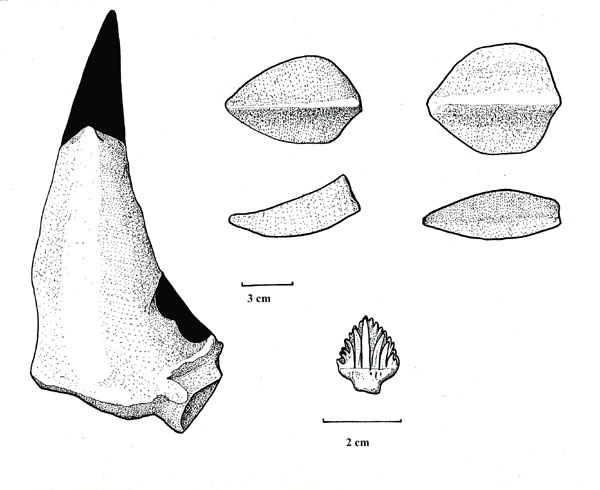
Species: horridus HUXLEY, 1867
Etymology: Latin, horridus, "frightful."
Syntypes: BGS GSM 109057, 109045-109046, 109051, 109053, 109046-109052, 109055-109056
Locality: Immediately east of Copt Point near the town of Folkstone, Kent County, England, Southern United Kingdom.
Horizon: From the Chalk Marl, 8 feet above the Upper Greensand.
Biostratigraphy: Mantelliceras mantelli zone.
Age: Lowermost Cenomanian Stage, Uppermiddle Gallic Subepoch, Lowermost Gulf Epoch, Middle Cretaceous.
Material:
Breakdown as follows.
BGS GSM 109057: Fragmentary basicranium.
109045-109046 (in part), 109051 (in part): 3 isolated teeth.
109053: Dorsal vertebra (doubtfully ankylosaurian, as per PEREDA-SUBERBIOLA & BARRETT, 1998).
109046-109052, 109055-109056: Dermal armor.

Figure 1), Large scapular spine, osteoderms and tooth.
Referred material:
= Camptosaurus CASEY, 1961/PEREDA-SUBERBIOLA & BARRETT, 1998
Locality: Wrotham, west Kent County, England, Southern United Kingdom.
Horizon: Junction of Folkestone beds and the Gault Clay, bed 8.
Biostratigraphy: Upper mammillatus zone.
Age: Uppermost Early Albian Stage, Middle Gallic Subepoch, Upper Early Cretaceous Epoch, Early Cretaceous.
Mateiral:
BMNH R6703: Dorsal centra.
= Acanthopholis horridus CASEY, 1961
Locality: Copt Point, Folkstone, Kent County, England, Southern United Kingdom.
Horizon: Gault Clay, Folkstone beds.
Biostratigraphy: Main mammillatu zone.
Age: Early Albian Stage, Middle Gallic Subepoch, Upper Early Cretaceous Epoch, Early Cretaceous.
Material:
BGS GSM Zk 4775: Vertebra.
LYDEKKER, 1888Locality: Flokestone, England, Southern United Kingdom.
Horizon: Chalk-Marl.
Biostratigraphy:
Age: Early Cretaceous.
Material:
BMNH 44581: An anterior caudal vertebrae, wanting the extremities of the transverse processes and the neural spine and the posterior zygapophses.
From Lydekker, 1888.
BMNH 47234: The centra of 2 dorsal vertebrae with 2 associated dermal scutes.
BMNH 47234a: 5 dermal scutes.
BMNH 49917: A dermal scutes.
BMNH 35280-2: 5 imperfect centra of posterior caudal vertebrae, provisionally referred to this species.
_____________________________________________________________________________________
Species: hughesii (SEELEY, 1871) (nomen nudum) as per PEREDA-SUBERBIOLA & BARRETT,
1998
Etymology:
Holotype: SMC B55463-SMC B55490
Locality: Cambridge, Cambridgeshire County, England, Southern United Kingdom.
Horizon: Cambridge Greensand.
Biostratigraphy:
Age: Albian Stage, Middle Gallic Subepoch, Upper Early Cretaceous Epoch, Early Cretaceous.
Material:
Breakdown as follows;
SMC B55484-555490: 5 keeled scutes and a pair of fragmentary spines.
SMC B55468-55474: Vertebrae.
SMC B55479: Metapodial bone.
The following is an indeterminate ornithopod.
SMC B55463-55467: Dorsal vertebrae.
The following is indeterminate beyond the Dinosaurian level.
SMC B55476, 555478, B55480-55483: Metopodial bones.
_____________________________________________________________________________________
Species: keepingi SEELEY, 1869 (nomen nudum) as per PEREDA-SUBERBIOLA & BARRETT,
1998
Etymology:
Holotype: SMC B55493, B55491-55526
Locality: Cambridge, Cambridgeshire County, England, Southern United Kingdom.
Horizon: Cambridge Greensand.
Biostratigraphy:
Age: Albian Stage, Middle Gallic Subepoch, Upper Early Cretaceous Epoch, Early Cretaceous.
Material:
Breakdown as follows…
SMC B55493: 5 dorsal and 6 caudal vertebrae.
SMC B55491-55492: Dorsal vertebrae.
SMC B55497-55500: Caudal vertebrae.
SMC B55514-55526: Dermal armor-keeled scutes, polygonal plates and ossicles.
The following is an indeterminate ornithopod
SMC B55494, B55903: Dorsal and caudal vertebrae.
A turtle
SMC B55509: Undetermined limb fragment.
The following is indeterminate beyond the dinosaurian level.
SMC B55495-55496, B55501-55502, B55510-55513: Chevrons, rib remains, metopodial and phalanges.
_____________________________________________________________________________________
Species: ? platypus SEELEY, 1871 (nomen dubium)
Etymology: Greek, platy, "flat" and Latin, pes, "foot."
= Acanthopholis platypus SEELEY, 1869 (nomen nudum)
= Acantopholis platypus KUHN, 1939 (sic)
Holotype: SMC B55454, B55455-55460
Locality: Out of a pit at Bottisham, near Cambridge, Cambridgeshire County, England, Southern United Kingdom.
Horizon: Upper Cambridge Greensand.
Biostratigraphy:
Age: Late Albian Stage, Middle Gallic Subepoch, Upper Early Cretaceous Epoch, Early Cretaceous.
Material:
Breakdown as follows;
SMC B55454: Phalanx.
SMC B55455-55460: Caudal centra.
Note: Ankylosauria incertae sedis as per PEREDA-SUBERBIOLA & BARRETT,
1998
Note: As per PEREDA-SUBERBIOLA & BARRETT, 1998..
SMC B55461: A fragmentary neural spine which cannot be identified beyond the
level of Dinosaurian indeterminate.
____________________________________________________________________________________
Species: macrocercus SEELEY, 1879 (nomen nudum)
Etymology: Greek, macro, "large" and Greek, kerkos, "tail."
Holotype: Sedgwick Museum, SMC B55599-55609
Locality: From the vicinity of Cambridge, Cambridgeshire County, England, Southern United Kingdom.
Horizon: Cambridge Greensand.
Biostratigraphy:
Age: Late Albian Stage, Middle Gallic Subepoch, Upper Early Cretaceous Epoch, Early Cretaceous.
Material: Keeled scutes.
Note: Ankylosauria incertae sedis as per PEREDA-SUBERBIOLA & BARRETT, 1998
Note: as per PEREDA-SUBERBIOLA & BARRETT, 1998…(see Syngosaurus macrocercus)
SMC B55571-55579, B55582-55586: Vertebrae of an ornithopod.
SMC B55570, B55580-55581, B55587: These elements cannot be identified beyond
the level of Dinosauria (see Dinosauria incertae sedis)
_____________________________________________________________________________________
Species: ? stereocercus SEELEY, 1879 (nomen dubium)
Etymology: Greek, steros, "solid, firm" and Greek, kerkos, "tail."
Holotype: SMC B55560, B55562, B55566-55568, B55569
Locality: The vicinity of Cambridge, Cambridgeshire County, England, Southern United Kingdom.
Horizon: Cambridge Greensand.
Biostratigraphy:
Age: Late Albian Stage, Middle Gallic Subepoch, Upper Early Cretaceous Epoch, Early Cretaceous.
Material: Breakdown as follows…
SMC B55560, B55562, B55566-555698: Caudal vertebrae.
SMC B55569: Dermal spine.
_____________________________________________________________________________________
Species: ? eucercus SEELEY, 1879 (nomen dubium)
Etymology: Greek, eu, "true" and Greek, kerkos, "tail."
Holotype: SMC B55552-55557
Locality: The vicinity of Cambridge, Cambridgeshire County, England, Southern United Kingdom.
Horizon: Cambridge Greensand.
Biostratigraphy:
Age: Late Albian Stage, Middle Gallic Subepoch, Upper Early Cretaceous Epoch, Early Cretaceous.
Material: 6 caudal vertebrae.
Note: Probably an Ornithopod incertae sedis.